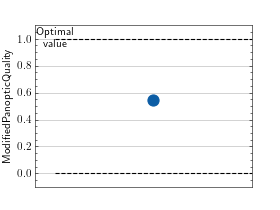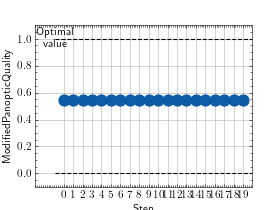Modified Panoptic Quality¶
Module Interface¶
- class torchmetrics.detection.ModifiedPanopticQuality(things, stuffs, allow_unknown_preds_category=False, **kwargs)[source]¶
Compute Modified Panoptic Quality for panoptic segmentations.
The metric was introduced in Seamless Scene Segmentation paper, and is an adaptation of the original Panoptic Quality where the metric for a stuff class is computed as
\[PQ^{\dagger}_c = \frac{IOU_c}{|S_c|}\]where \(IOU_c\) is the sum of the intersection over union of all matching segments for a given class, and \(|S_c|\) is the overall number of segments in the ground truth for that class.
- Parameters:
things¶ (
Collection[int]) – Set ofcategory_idfor countable things.stuffs¶ (
Collection[int]) – Set ofcategory_idfor uncountable stuffs.allow_unknown_preds_category¶ (
bool) – Boolean flag to specify if unknown categories in the predictions are to be ignored in the metric computation or raise an exception when found.
- Raises:
ValueError – If
things,stuffshave at least one commoncategory_id.TypeError – If
things,stuffscontain non-integercategory_id.
Example
>>> from torch import tensor >>> from torchmetrics.detection import ModifiedPanopticQuality >>> preds = tensor([[[0, 0], [0, 1], [6, 0], [7, 0], [0, 2], [1, 0]]]) >>> target = tensor([[[0, 1], [0, 0], [6, 0], [7, 0], [6, 0], [255, 0]]]) >>> pq_modified = ModifiedPanopticQuality(things = {0, 1}, stuffs = {6, 7}) >>> pq_modified(preds, target) tensor(0.7667, dtype=torch.float64)
- plot(val=None, ax=None)[source]¶
Plot a single or multiple values from the metric.
- Parameters:
val¶ (
Union[Tensor,Sequence[Tensor],None]) – Either a single result from calling metric.forward or metric.compute or a list of these results. If no value is provided, will automatically call metric.compute and plot that result.ax¶ (
Optional[Axes]) – An matplotlib axis object. If provided will add plot to that axis
- Return type:
- Returns:
Figure object and Axes object
- Raises:
ModuleNotFoundError – If matplotlib is not installed
>>> from torch import tensor >>> from torchmetrics.detection import ModifiedPanopticQuality >>> preds = tensor([[[[6, 0], [0, 0], [6, 0], [6, 0]], ... [[0, 0], [0, 0], [6, 0], [0, 1]], ... [[0, 0], [0, 0], [6, 0], [0, 1]], ... [[0, 0], [7, 0], [6, 0], [1, 0]], ... [[0, 0], [7, 0], [7, 0], [7, 0]]]]) >>> target = tensor([[[[6, 0], [0, 1], [6, 0], [0, 1]], ... [[0, 1], [0, 1], [6, 0], [0, 1]], ... [[0, 1], [0, 1], [6, 0], [1, 0]], ... [[0, 1], [7, 0], [1, 0], [1, 0]], ... [[0, 1], [7, 0], [7, 0], [7, 0]]]]) >>> metric = ModifiedPanopticQuality(things = {0, 1}, stuffs = {6, 7}) >>> metric.update(preds, target) >>> fig_, ax_ = metric.plot()

>>> # Example plotting multiple values >>> from torch import tensor >>> from torchmetrics.detection import ModifiedPanopticQuality >>> preds = tensor([[[[6, 0], [0, 0], [6, 0], [6, 0]], ... [[0, 0], [0, 0], [6, 0], [0, 1]], ... [[0, 0], [0, 0], [6, 0], [0, 1]], ... [[0, 0], [7, 0], [6, 0], [1, 0]], ... [[0, 0], [7, 0], [7, 0], [7, 0]]]]) >>> target = tensor([[[[6, 0], [0, 1], [6, 0], [0, 1]], ... [[0, 1], [0, 1], [6, 0], [0, 1]], ... [[0, 1], [0, 1], [6, 0], [1, 0]], ... [[0, 1], [7, 0], [1, 0], [1, 0]], ... [[0, 1], [7, 0], [7, 0], [7, 0]]]]) >>> metric = ModifiedPanopticQuality(things = {0, 1}, stuffs = {6, 7}) >>> vals = [] >>> for _ in range(20): ... vals.append(metric(preds, target)) >>> fig_, ax_ = metric.plot(vals)

Functional Interface¶
- torchmetrics.functional.detection.modified_panoptic_quality(preds, target, things, stuffs, allow_unknown_preds_category=False)[source]¶
Compute Modified Panoptic Quality for panoptic segmentations.
The metric was introduced in Seamless Scene Segmentation paper, and is an adaptation of the original Panoptic Quality where the metric for a stuff class is computed as
\[PQ^{\dagger}_c = \frac{IOU_c}{|S_c|}\]where \(IOU_c\) is the sum of the intersection over union of all matching segments for a given class, and \(|S_c|\) is the overall number of segments in the ground truth for that class.
- Parameters:
preds¶ (
Tensor) – torch tensor with panoptic detection of shape [height, width, 2] containing the pair (category_id, instance_id) for each pixel of the image. If the category_id refer to a stuff, the instance_id is ignored.target¶ (
Tensor) – torch tensor with ground truth of shape [height, width, 2] containing the pair (category_id, instance_id) for each pixel of the image. If the category_id refer to a stuff, the instance_id is ignored.things¶ (
Collection[int]) – Set ofcategory_idfor countable things.stuffs¶ (
Collection[int]) – Set ofcategory_idfor uncountable stuffs.allow_unknown_preds_category¶ (
bool) – Boolean flag to specify if unknown categories in the predictions are to be ignored in the metric computation or raise an exception when found.
- Raises:
ValueError – If
things,stuffshave at least one commoncategory_id.TypeError – If
things,stuffscontain non-integercategory_id.TypeError – If
predsortargetis not antorch.Tensor.ValueError – If
predsortargethas different shape.ValueError – If
predshas less than 3 dimensions.ValueError – If the final dimension of
predshas size != 2.
- Return type:
Example
>>> from torch import tensor >>> preds = tensor([[[0, 0], [0, 1], [6, 0], [7, 0], [0, 2], [1, 0]]]) >>> target = tensor([[[0, 1], [0, 0], [6, 0], [7, 0], [6, 0], [255, 0]]]) >>> modified_panoptic_quality(preds, target, things = {0, 1}, stuffs = {6, 7}) tensor(0.7667, dtype=torch.float64)
